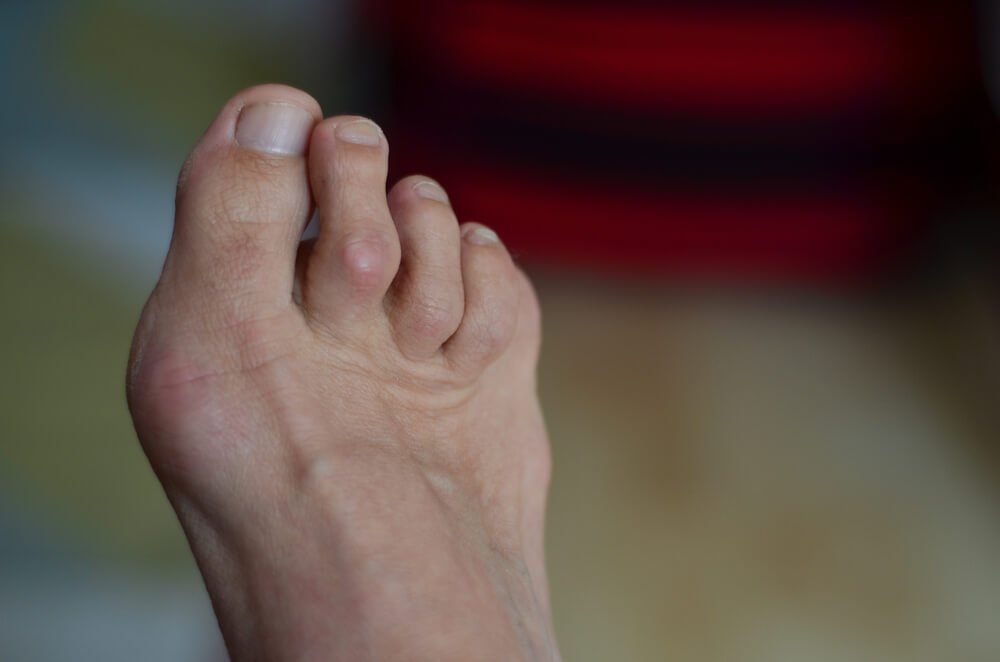-
A hammer toe is a contracture, or bending, of the toe at the first joint of the digit, called the proximal interphalangeal joint. This bending causes the toe to appear like an upside-down V when looked at from the side. Any toe can be involved, but the condition usually affects the second through fifth toes, known as the lesser digits. Hammer toes are more common in females than males. There are two different types:
Flexible Hammer Toes: These hammer toes are less serious because they can be diagnosed and treated while still in the developmental stage. They are called flexible hammer toes because they are still moveable at the joint.
Rigid Hammer Toes: This variety is more developed and more serious than the flexible condition. Rigid hammer toes can be seen in patients with severe arthritis, for example, or in patients who wait too long to seek professional treatment. The tendons in a rigid hammer toe have become tight, and the joint misaligned and immobile, making surgery the usual course of treatment.
-
The symptoms of a hammer toe include the following:
Pain at the top of the bent toe upon pressure from footwear
Formation of corns on the top of the joint
Redness and swelling at the joint contracture
Restricted or painful motion of the toe joint
Pain in the ball of the foot at the base of the affected to
-
What can you do for relief?
Apply a commercial, non-medicated hammer toe pad around the bony prominence of the hammer toe to decrease pressure on the area.
Wear a shoe with a deep toe box.
If the hammer toe becomes inflamed and painful, apply ice packs several times a day to reduce swelling.
Avoid heels more than two inches tall.
A loose-fitting pair of shoes can also help protect the foot while reducing pressure on the affected toe, making walking a little easier until a visit to your podiatrist can be arranged. While this treatment will make the hammer toe feel better, it is important to remember that it does not cure the condition. A trip to the podiatrist's office will be necessary to repair the toe to allow for normal foot function.
Avoid wearing shoes that are too tight or narrow. Children should have their shoes properly fitted on a regular basis, as their feet can often outgrow their shoes rapidly.
-
If pain persists, see a podiatrist. If left untreated, hammer toes tend to become rigid, making non-surgical treatment less of an option.
-
The treatment options vary with the type and severity of each hammer toe, although identifying the deformity early in its development is important to avoid surgery. Your podiatrist will examine and X-ray the affected area and recommend a treatment plan specific to your condition.
Padding and Taping: Often padding and taping are the first steps in a treatment plan. Padding the hammer toe prominence minimizes pain and allows the patient to continue a normal, active life. Taping may change the imbalance around the toes and thus relieve the stress and pain.
Medication: Anti-inflammatory drugs and cortisone injections can be prescribed to ease acute pain and inflammation caused by the joint deformity.
Orthotic Devices: Custom shoe inserts made by your podiatrist may be useful in controlling foot function. An orthotic device may reduce symptoms and prevent the worsening of the hammer toe deformity.
Surgical Options: Several surgical procedures are available to the podiatrist For less severe deformities, the surgery will remove the bony prominence and restore normal alignment of the toe joint, thus relieving pain. Severe hammer toes, which are not fully reducible, may require more complex surgical procedures.
Recuperation takes time, and some swelling and discomfort are common for several weeks following surgery. Any pain, however, is easily managed with medications prescribed by your podiatrist.
-
There are several things you can do to help prevent hammer toes from forming or progressing:
Wear supportive shoes to help prevent deformities. Hammer toes are often related to faulty foot mechanics, especially foot flattening.
Wear custom orthotics prescribed by your podiatrist. Orthotics may slow the progression or prevent the development of hammer toes.
Avoid shoes with narrow or pointed toe boxes that can compress the toes.
LEARN HOW NYSPMA PODIATRISTS HELP KEEP YOU HEALTHIER

